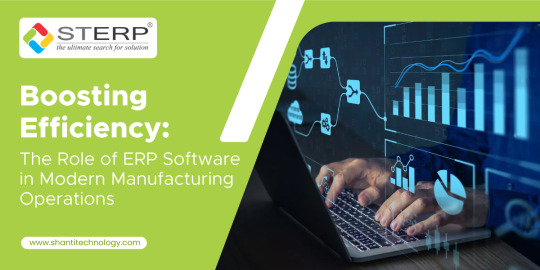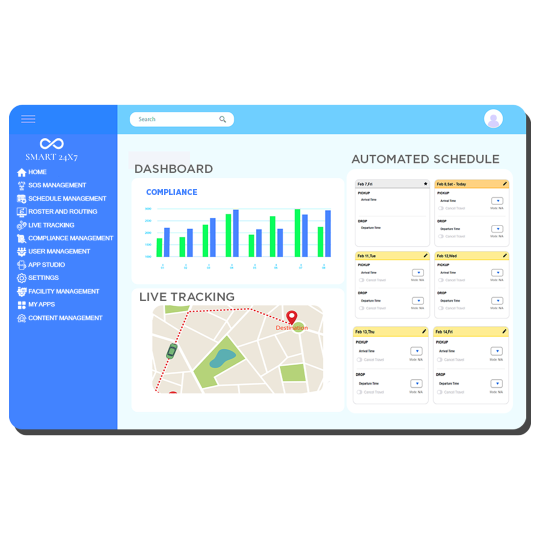#Employee Transport Management Software
Explore tagged Tumblr posts
Text
India's #1 Employee Transport Management Software | Smart24x7

Smart24x7 provides the leading Employee Transport Management Software, ensuring safe, automated, and efficient employee commutes. Our software offers real-time tracking, route optimization, and compliance management, making corporate transportation seamless, secure, and cost-effective.
0 notes
Text
For many employees, the daily commute is a source of constant frustration. Long hours spent stuck in traffic or waiting for late buses lead to fatigue and stress, while employers struggle with the repercussions of late arrivals and decreased accountability. This chaotic routine not only affects productivity but also diminishes workplace morale.
#employee transport management system#employee transport automation#employee transport management software
0 notes
Text
Revolutionizing Employee Transportation: The Role of Employee Transport Management Software in Office Shuttle and Cab Operations
In today's fast-paced world, the logistics of getting employees to and from the workplace efficiently can be a significant challenge for businesses. As companies strive to enhance employee satisfaction and streamline operations, the focus on robust transportation solutions has intensified. Employee Transport Management Software (ETMS), office shuttles, and office cabs are at the forefront of this transformative journey, offering innovative ways to manage corporate transportation needs effectively. This article delves into how these solutions are revolutionizing employee transportation, making the daily commute smoother and more efficient.
The Emergence of Employee Transport Management Software
At the core of modernizing corporate commute systems is Employee Transport Management Software. This sophisticated platform automates and optimizes the planning, execution, and monitoring of employee transport operations. By leveraging ETMS, companies can achieve a seamless integration of office shuttles and office cabs services, ensuring a timely, safe, and cost-effective transportation experience for their workforce.
The Employee Transport Management Software is designed to address the complexities of managing large fleets and diverse employee schedules. It intelligently routes vehicles, predicts travel times, and allocates resources in real-time, considering traffic patterns and employee locations. This dynamic approach not only enhances efficiency but also significantly reduces the environmental footprint by optimizing routes and reducing idle times.
Transforming Commutes with Office Shuttles
Office shuttle have long been a staple in employee transportation, offering a reliable and efficient means for groups of employees to travel together. With the integration of Employee Transport Management Software, the operation of office shuttles has been elevated to new heights. The software enables precise scheduling and route optimization, ensuring that shuttles are fully utilized and arrive at their destinations on time.
Moreover, office shuttles supported by advanced ETMS can provide a more personalized and flexible service. Employees can book seats on shuttles in advance, receive real-time updates on vehicle location, and even adjust their travel plans on the fly. This level of service not only improves employee satisfaction but also encourages the use of shared transportation options, aligning with sustainability goals.
The Role of Office Cabs in Personalized Commute Solutions
For individual travel needs or last-mile connectivity, office cabs play a crucial role. Integrated with Employee Transport Management Software, these cab services can be dispatched efficiently, matching employees with the nearest available vehicle. This system significantly cuts down waiting times and enhances the overall employee experience.
Office cabs, when managed through ETMS, offer unparalleled flexibility and convenience. Employees can request rides according to their schedules, making it an ideal option for those working late hours or in need of emergency transportation. Furthermore, the software's analytical capabilities allow for continuous improvement of the service by tracking performance metrics and identifying areas for enhancement.
Achieving Operational Excellence
The implementation of Employee Transport Management Software in managing office shuttles and office cabs brings about operational excellence. By automating routine tasks, the software reduces the administrative burden on staff, allowing them to focus on strategic aspects of transportation management. The data-driven insights provided by ETMS enable companies to make informed decisions regarding fleet size, vehicle types, and service frequencies.
Safety is another critical aspect significantly bolstered by ETMS. With features such as real-time tracking, driver performance monitoring, and emergency response mechanisms, companies can ensure a high level of safety for their employees during transit. This commitment to safety further enhances employee trust and satisfaction with the company's transportation services.
Looking Ahead: The Future of Employee Transportation
The integration of Employee Transport Management Software into the operation of office shuttles and office cabs represents a significant leap forward in the domain of corporate transportation. As technology continues to advance, we can expect even more innovative features to be added to ETMS, such as AI-driven predictive analytics, enhanced user interfaces, and integration with smart city infrastructure.
The future of employee transportation looks promising, with Employee Transport Management Software playing a pivotal role in making commutes more efficient, sustainable, and enjoyable. As companies continue to adopt and invest in these technologies, the daily travel experience of millions of employees worldwide will be transformed for the better.
In conclusion, the role of Employee Transport Management Software in revolutionizing office transportation is undeniable. By optimizing the operation of office shuttles and office cabs, ETMS not only improves the daily commute for employees but also contributes to the broader objectives of cost efficiency, sustainability, and employee well-being. As we move forward, the continued evolution and adoption of these technologies will undoubtedly shape the future of workplace transportation.
0 notes
Text
iSpot4u provides reliable employee transportation system. India's best transpotation management solution. Reliable transportation management solution by iSpot4u
#employee transportation system#employee transport management system#employee transport management software#employee transportation solution
0 notes
Text
Engineers who work for Elon Musk’s SpaceX have been brought on as senior advisers to the acting administrator of the Federal Aviation Administration (FAA), sources tell WIRED.
On Sunday, Sean Duffy, secretary of the Department of Transportation, which oversees the FAA, announced in a post on X that SpaceX engineers would be visiting the Air Traffic Control System Command Center in Virginia to take what he positioned as a tour. “The safety of air travel is a nonpartisan matter,” Musk replied. “SpaceX engineers will help make air travel safer.”
By the time these posts were made, though, according to sources who were granted anonymity because they fear retaliation, SpaceX engineers were already being onboarded at the agency under Schedule A, a special authority that allows government managers to “hire persons with disabilities without requiring them to compete for the job,” according to the Office of Personnel Management (OPM).
These new hires come after the terminations of hundreds of FAA probationary employees, and the most deadly month of US aviation disasters in more than a decade.
According to a source with knowledge of the situation, none of the SpaceX engineers were fully vetted by their start date. Unlike the very young technologists associated with Musk’s so-called Department of Government Efficiency (DOGE) who have been given access to critical systems at agencies ranging from OPM and the Treasury Department to the National Oceanic and Atmospheric Administration in recent weeks, though, the engineers identified by WIRED—Ted Malaska, Thomas Kiernan, Sam Smeal, and Brady Glantz—do appear to have experience relevant to the FAA.
Malaska is currently, according to his LinkedIn profile, a senior director of application software at SpaceX, where he started working in May 2021. Formerly the senior director of data engineering at Capitol One and a senior architect at FINRA, he graduated from the University of Maryland Baltimore County in 2000 and cowrote a 2015 book on Hadoop application architectures.
Kiernan is currently a lead software engineer at SpaceX, according to his LinkedIn page. Before joining SpaceX in May 2020, he worked at Wayfair and is a 2017 Dartmouth graduate.
Smeal is a software engineer who has worked at SpaceX since September 2021, according to his LinkedIn. He graduated from Saint Vincent College in 2018.
Glantz is a software engineer who has worked at SpaceX since May 2024 and worked as an engineering analyst at Goldman Sachs from 2019 to 2021, according to his LinkedIn, and graduated from the University of Michigan in 2019.
Malaska, Kiernan, Smeal, and Glantz did not immediately respond to requests for comment. The FAA also did not immediately respond to requests for comment.
In his post on X, Duffy wrote, "Because I know the media (and Hillary Clinton) will claim Elon’s team is getting special access, let me make clear that the @FAANews regularly gives tours of the command center to both media and companies.”
But on Wednesday, FAA acting administrator Chris Rocheleau wrote in an email to FAA staff, viewed by WIRED, that DOGE and the teams of special government employees deployed in federal agencies were “top-of-mind,” before noting that the agency had "recently welcomed” a team of special government employees who had already toured some FAA facilities. “We are asking for their help to engineer solutions while we keep the airspace open and safe,” he wrote, adding that the new employees had already visited the FAA Command Center and Potomac TRACON, a facility that controls the airspace around and provides air traffic control services to airports in the DC, Maryland, and Virginia areas.
In a Department of Transportation all-hands meeting late last week, Duffy responded to a question about DOGE's role in national airspace matters, and without explicitly mentioning the new employees, suggested help was needed on reforming Notice to Air Mission (NOTAM) alerts, a critical system that distributes real-time data and warnings to pilots but which has had significant outages, one as recently as this month. “If I can get ideas from really smart engineers on how we can fix it, I’m going to take those ideas,” he said, according to a recording of the meeting reviewed by WIRED. “Great engineers” might also work on airspace issues, he said.
SpaceX functioned as the pre-inauguration staging ground for the DOGE team, according to reporting from The New York Times and sources who spoke to WIRED. In the months between November 5 and January 20, members of DOGE including Steve Davis (president of Musk’s Boring Company) and the young engineer Luke Farritor were operating out of the company’s DC office, according to a source with knowledge.
The company did not respond to questions about whether these employees will retain their salaries and positions at the company during their time with DOGE. Many of the so-called department’s operatives have joined as “special government employees,” who are limited to working 130 days in a year. Last week WIRED reported that Tom Krause, a DOGE operative at the Treasury Department, would continue to maintain his position as CEO of the Cloud Software Group while also performing the duties of fiscal assistant secretary. Other members of Musk’s companies, including xAI and Tesla, have also taken on positions with DOGE.
Late last week, the Trump administration laid off 400 FAA workers, according to their union, the Professional Aviation Safety Specialists. The union says these included probationary employees who worked on air traffic control communications and related radio and computer systems. Air traffic controllers were not affected by the layoffs, Duffy said in an X post.
Just two weeks before that, the US suffered its most deadly aviation incident in more than a decade, when 67 people died after an Army helicopter collided with a passenger jet in Washington, DC. Though initial findings suggest complex equipment and communications issues possibly played roles in the disaster, President Trump was quick to blame “DEI,” railing against a decade-old program that helps the FAA identify talent among populations with disabilities. People with disabilities hired into the FAA and other federal agencies are often accepted under the Schedule A authority—exactly the route these new engineers have taken into the agency.
The FAA has frequently tangled with Musk’s SpaceX, as the rocket company and others fight to operate their own interests in crowded American airspace. In January, the FAA temporarily grounded SpaceX’s program after one of its Starship rockets broke apart midflight, reportedly damaging public property on Turks and Caicos in the Caribbean. The FAA diverted dozens of commercial airline flights following the explosion and announced an investigation into the incident, which is ongoing and being led by SpaceX. Musk, however, characterized the failure as “barely a bump in the road” and did not seem to indicate that the investigation would slow SpaceX’s launch cadence. Last year, the company indicated it was aiming for 25 launches of the Starship in 2025.
FAA spokesperson Steven Kulm told WIRED that “the FAA is overseeing the SpaceX-led mishap investigation.” The FAA did not respond to further questions about whether the presence of SpaceX engineers at the agency would constitute a conflict of interest.
In September, the FAA proposed $633,000 in fines following two 2023 incidents in which SpaceX allegedly did not follow its license requirements, violating regulations. Responding to an X user posting about the penalties, Musk wrote, “The fundamental problem is that humanity will forever be confined to Earth unless there is radical reform at the FAA!” Shortly afterward, Musk called for FAA head Mike Whitaker to resign.
In January, more than three years before his term was due to end, Whitaker did resign.
“I told Elon, any conflicts, you can’t have anything to do with that,” said President Trump in a press conference this week, in response to a question about Musk, SpaceX, the FAA, and conflicts of interest. “So anything to do with possibly even space, we won’t let Elon partake in that.”
The White House did not immediately respond to a request for comment.
SpaceX is directly regulated by a small FAA agency called the Office of Commercial Space Transportation, which since 1984 has licensed the launch of US space rockets. “The purpose is to ensure public safety,” says George Nield, a former associate administrator of the office. “People on the ground did not consent” to rocket launches above them, he says. ”We absolutely need to keep them safe. The office has done a great job of that.” The office oversaw 157 launches in 2024 alone.
On February 10, several days after Musk posted on X that DOGE “will aim to make rapid safety upgrades to the air traffic control system,” a group of Democratic legislators wrote to Rocheleau—a career civil servant whose ties to the FAA go back to 1996—requesting information about any planned changes to FAA systems.
“We are extremely concerned that an ad hoc team of individuals lacking any expertise, exposure, certifications, or knowledge of aviation operations being invited, or inserting themselves, to make ‘rapid’ changes to our nation’s air traffic systems,” they wrote. “Aviation safety is not an area to ‘move fast and break things.’”
7 notes
·
View notes
Text
Boosting Efficiency: The Role of ERP Software in Modern Manufacturing Operations
In today's fast-paced manufacturing landscape, efficiency is not just a desirable trait; it's a necessity. To stay competitive and meet the demands of the market, manufacturers must streamline their processes, optimize resource utilization, and enhance decision-making capabilities. This is where Enterprise Resource Planning (ERP) software steps in as a game-changer. In this article, we'll delve into the pivotal role of ERP systems in revolutionizing manufacturing operations, particularly in India's thriving industrial sector.

Understanding ERP for Manufacturing Industry
ERP systems for manufacturing are comprehensive software solutions designed to integrate and automate core business processes such as production planning, inventory management, supply chain logistics, financial management, and human resources. By consolidating data and operations into a unified platform, ERP empowers manufacturers with real-time insights, facilitates collaboration across departments, and enables informed decision-making.
Streamlining Operations with ERP Solutions
In the dynamic environment of manufacturing, where every minute counts, efficiency gains translate directly into cost savings and competitive advantages. ERP software for manufacturing offers a multitude of features that streamline operations and drive efficiency:
1. Enhanced Production Planning: ERP systems enable manufacturers to create accurate production schedules based on demand forecasts, resource availability, and production capacity. By optimizing production timelines and minimizing idle time, manufacturers can fulfill orders promptly and reduce lead times.
2. Inventory Management: Efficient inventory management is crucial for balancing supply and demand while minimizing holding costs. ERP software provides real-time visibility into inventory levels, automates reorder points, and facilitates inventory optimization to prevent stockouts and overstock situations.
3. Supply Chain Optimization: ERP solutions for manufacturing integrate supply chain processes from procurement to distribution, enabling seamless coordination with suppliers and distributors. By optimizing procurement cycles, minimizing transportation costs, and reducing lead times, manufacturers can enhance supply chain resilience and responsiveness.
4. Quality Control: Maintaining product quality is paramount in manufacturing to uphold brand reputation and customer satisfaction. ERP systems offer quality management modules that streamline inspection processes, track product defects, and facilitate corrective actions to ensure adherence to quality standards.
5. Financial Management: Effective financial management is essential for sustaining manufacturing operations and driving profitability. ERP software provides robust accounting modules that automate financial transactions, streamline budgeting and forecasting, and generate comprehensive financial reports for informed decision-making.
6. Human Resource Management: People are the cornerstone of manufacturing operations, and managing workforce efficiently is critical for productivity and employee satisfaction. ERP systems for manufacturing include HR modules that automate payroll processing, manage employee records, and facilitate workforce planning to align staffing levels with production demands.
The Advantages of ERP for Manufacturing Companies in India
India's manufacturing sector is undergoing rapid transformation, fueled by factors such as government initiatives like "Make in India," technological advancements, and globalization. In this dynamic landscape, ERP software plays a pivotal role in empowering manufacturing companies to thrive and remain competitive:
1. Scalability: ERP solutions for manufacturing are scalable, making them suitable for companies of all sizes – from small and medium enterprises (SMEs) to large conglomerates. Whether a company is expanding its operations or diversifying its product portfolio, ERP systems can adapt to evolving business needs and support growth.
2. Compliance: Regulatory compliance is a significant concern for manufacturing companies in India, given the complex regulatory environment. ERP software incorporates compliance features that ensure adherence to industry regulations, tax laws, and reporting requirements, minimizing the risk of non-compliance penalties.
3. Localization: ERP vendors catering to the Indian manufacturing sector offer localized solutions tailored to the unique requirements of the Indian market. From multi-currency support to GST compliance features, these ERP systems are equipped with functionalities that address the specific challenges faced by Indian manufacturers.
4. Cost Efficiency: Implementing ERP software for manufacturing entails upfront investment, but the long-term benefits far outweigh the costs. By streamlining processes, optimizing resource utilization, and reducing operational inefficiencies, ERP systems drive cost savings and improve overall profitability.
5. Competitive Edge: In a fiercely competitive market, manufacturing companies in India must differentiate themselves through operational excellence and agility. ERP software equips companies with the tools and insights needed to outperform competitors, adapt to market dynamics, and capitalize on emerging opportunities.
Choosing the Right ERP Software for Manufacturing
Selecting the right ERP solution is crucial for maximizing the benefits and ensuring a smooth implementation process. When evaluating ERP software for manufacturing, companies should consider the following factors:
1. Industry-specific functionality: Choose an ERP system that offers industry-specific features and functionalities tailored to the unique requirements of manufacturing operations.
2. Scalability and flexibility: Ensure that the ERP software can scale with your business and accommodate future growth and expansion.
3. Ease of integration: Look for ERP systems that seamlessly integrate with existing software applications, such as CRM systems, MES solutions, and IoT devices, to create a cohesive technology ecosystem.
4. User-friendliness: A user-friendly interface and intuitive navigation are essential for ensuring widespread adoption and maximizing user productivity.
5. Vendor support and expertise: Select a reputable ERP vendor with a proven track record of success in the manufacturing industry and robust customer support services.
Conclusion
In conclusion, ERP software has emerged as a cornerstone of modern manufacturing operations, empowering companies to enhance efficiency, drive growth, and maintain a competitive edge in the global market. For manufacturing companies in India, where agility, scalability, and compliance are paramount, implementing the right ERP solution can be a transformative investment that paves the way for sustainable success. By harnessing the power of ERP, manufacturers can optimize processes, streamline operations, and unlock new opportunities for innovation and growth in the dynamic landscape of the manufacturing industry.
#ERP software providers in India#Manufacturing enterprise resource planning#ERP systems for manufacturing companies#ERP system for manufacturing industry#ERP for manufacturing companies#ERP software for engineering company#ERP software for engineering companies in India#ERP software for engineering companies in Mumbai#ERP solution providers in India#ERP for manufacturing industry#ERP systems for manufacturing#ERP solutions for manufacturing#ERP software manufacturing industry#ERP for manufacturing company in India#India
8 notes
·
View notes
Text
Master GHG ACCOUNTING CARBON FOOTPRINT Training with 4C Consulting

Understanding greenhouse gas (GHG) emissions and accurately accounting for your organization’s carbon footprint is critical in today’s environmentally conscious world. GHG ACCOUNTING CARBON FOOTPRINT Training is essential for businesses aiming to reduce their environmental impact and achieve sustainability goals. This blog will delve into the understanding, importance, and training aspects of GHG ACCOUNTING CARBON FOOTPRINT, highlighting why 4C Consulting is the best partner for this training.
Understanding GHG ACCOUNTING CARBON FOOTPRINT
Definition: GHG accounting is the process of measuring the amount of greenhouse gases emitted directly or indirectly by an organization, product, or service. It involves identifying and quantifying emissions from various sources such as energy use, transportation, waste, and industrial processes.
Purpose: The primary purpose of GHG accounting is to provide a clear and comprehensive picture of an organization’s carbon footprint, enabling it to track emissions, set reduction targets, and implement strategies to mitigate its impact on climate change.
Importance of GHG ACCOUNTING CARBON FOOTPRINT
Regulatory Compliance: Many regions and countries have stringent regulations and reporting requirements for GHG emissions. Accurate accounting ensures compliance with these regulations, avoiding potential fines and penalties.
Sustainability Goals: Understanding and managing carbon footprint is crucial for achieving sustainability targets. It allows organizations to identify key areas for improvement and develop effective carbon reduction strategies.
Corporate Responsibility: Demonstrating a commitment to reducing GHG emissions enhances an organization’s reputation and credibility. It shows stakeholders, including customers, investors, and employees, that the company is serious about its environmental responsibilities.
Cost Savings: Identifying inefficiencies in energy use and other processes through GHG accounting can lead to significant cost savings. Reducing emissions often goes hand-in-hand with reducing energy consumption and improving operational efficiency.
Market Advantage: As consumers and businesses become more environmentally conscious, demonstrating a low carbon footprint can provide a competitive advantage. It can differentiate a company’s products and services in a crowded marketplace.
GHG ACCOUNTING CARBON FOOTPRINT Training
Comprehensive Curriculum: The training covers all aspects of GHG accounting, including the principles of carbon footprint measurement, data collection and analysis, and reporting standards.
Hands-on Practice: Participants engage in practical exercises and case studies to apply the concepts learned. This helps in understanding real-world applications and challenges.
Tools and Techniques: The training provides knowledge about various tools and software used in GHG accounting. It includes guidance on selecting the appropriate methods for different organizational needs.
Regulatory Framework: Understanding the regulatory environment is a critical part of the training. Participants learn about national and international regulations and how to ensure compliance.
Reporting and Communication: The training includes modules on effectively reporting and communicating GHG emissions data to stakeholders. This is crucial for transparency and maintaining trust.
Why Choose 4C Consulting?
4C Consulting is renowned for its expertise and comprehensive approach to GHG ACCOUNTING CARBON FOOTPRINT Training. Our experienced trainers provide tailored solutions to meet the specific needs of your organization. With a strong focus on practical application and regulatory compliance, 4C Consulting ensures that your team is well-equipped to manage and reduce your carbon footprint. Choose 4C Consulting to gain the knowledge and skills necessary to drive your organization’s sustainability initiatives and enhance your environmental performance.
GHG ACCOUNTING CARBON FOOTPRINT Training is vital for organizations committed to sustainability and regulatory compliance. Understanding and managing carbon emissions not only benefit the environment but also provide significant operational and reputational advantages. With 4C Consulting, you can ensure your team receives the best training to achieve these goals effectively. Contact us now.
2 notes
·
View notes
Note
Let’s watch!

*clicks a button* Now... time to begin the presentation...

(Here it goes...)
...
...
[X]

'Welcome new employees, to Future Foundation - an organization that is to defeat the Ultimate Despair and undo the damage their actions had brought upon the world...'

'Future Foundation has 15 Division and Heads that you can choose to work under, here we are to introduce our leaders of each organization!'

'The Leader of Future Foundation and head of the 1st Division; Kazuo Tengan, he was Hope's Peak Former Headmaster which his duty is to provide overall directions and leadership of Future Foundation and help lead Future Foundation to prosper but sadly as of recent, he's going to be going into retirement due to medical reasons, however fear not - soon another will take his place...'

'The Vice-Chairmen of Future Foundation and head of the 2nd Division is Kyosuke Munakata; Now while he isn't leader yet, he will lead soon and we can see why as his Division manage day-to-day operations of the Future Foundation, construction of facility; expansion of organization; military and peacekeeping force!'

'Head of the 3rd Division; Koichi Kizakira who help in the creation of the training video also helps with Human resources, include scouting for potential members and personnel assignments. He often will go out and find those that would join our foundation which he likely presented this video to you - he is very likely the most hard-working of all the foundation head!'

'Seiko Kimura, she is the head of the 4th Division which is in charge of Research and develop medical techniques, often her clinics and medications will assist those in need and provide aid if there is no room at hospitals, come to Seiko's clinic for all your needs!'

'Kyoko Kirigiri which she's the head of the 5th Division which helps with Intelligence, Inquiry, and Counter-Espionage. Given her actions in the killing school life and how she assisted with taking down Junko Enoshima, it was agree upon that she would become a Future Foundation Head, so who better then Kyoko to help with cases!'

'Juzo Sakakura who is in charge of Policing, including riot suppression and investigate special crimes; often leading the charge investigation after the 5th Division has gather information while the 6th Division handles those cases so you can rely on Juzo as well.'

'Miaya Gekkogahara who's the head of the 7th Division which she helps with Information System security and administration along with Research and develop therapy to cure Despair. She even helped created the Neo World Program - a software that is to be made public to help people worldwide! Truly an amazing programmer!'

'In charge of the whole 8th Division, young Otoha Yasuda which helps with Long-term stable food procurement. Even creating shelters and orphanages for those that need a roof over their head so if you want to help people in need, work in the 8th Division.'

'Hideyoshi Tamon, he's in charge of the 9th Division which helps with Armament R&D, Production, and distribution. Offering weapons to other Division to help combat despairs so if you want to help with weapon productions do work here.'

'In charge of assistance in reviving education, culture and religion; Mio Yonaga is the 10th Division Head which helps to restore history, culture and world heritage sites which she has become quite the figurehead for all Future Foundation - even many referring to her as 'Mother Mio' which she plans to bring back education and history.'

'Daisaku Bandai, Head of the 11th Division which often helps with assistance in restoring agriculture in disaster area. He is working on ways to assist with the pollution. He is often working with the 8th Division to provide food for them - they are a very strong duo.'

'Head of the 12th Division; Gozu helps with assisting in restoring infrastructure; such as transportation, communication, and public facilities which he's even restore entire cities and towns phone-line and even can fight as well!'

'Head of the 13th Division; Ernesto Gomez who is in charge of restoring Law and the Jurisdiction; while he doesn't come around as often he is quite busy restoring law and even is in contact with other Division so if you wish to help with that; join this Division.'

'???? Is the head of the 14th Division - they are in charge of Public Relations; spreading news of Future Foundation's activities to the public. They also travel around the world and work on restoring relations and putting an end to riots!'

'And finally, the head of the 15th Division, Biju Hakoda which he leads to restoring Economics, Money, Banking and Commercialism which even during the tragedy; he was able to house many of those that suffer from the tragedy leading to him being a Future Foundation head!'
'As say, working at Future Foundation leads to you help people and leading to a hopeful future, so if you want to join - join today and work towards a bright and shining future for the sake of Hope.'
*CLICK!*

*stands up* Now that you know Future Foundation, you can ask any questions you want and I'll tell you to the best of my abilities!
#dr#danganronpa#dtfa#despair to future arc#fs:rw#future side: re write#sdr2#super danganronpa 2#dr3#danganronpa 3#dr:thh#danganronpa: trigger happy havoc#nagi nanami#hajime hinata#kazuo tengan#kyosuke munakata#koichi kizakura#seiko kimura#kyoko kirigiri#juzo sakakura#miaya gekkogahara#otoha yasuda#hideyoshi tamon#mio yonaga#daisaku bandai#great gozu#ernesto gomez#makoto naegi#biju hakoda#anonymous
3 notes
·
View notes
Text
Commercial EV Charger: Powering the Future of Sustainable Business.
As the world accelerates toward sustainable transportation, electric vehicles (EVs) are becoming a common sight on roads everywhere. Businesses, government institutions, and commercial properties are recognizing the need to provide EV charging infrastructure not just as a convenience, but as a necessity.
A Commercial EV Charger serves as the backbone for this infrastructure, offering powerful, reliable, and scalable charging solutions for electric vehicle fleets, customers, and employees alike.
What Is a Commercial EV Charger?
A Commercial EV Charger is an electric vehicle charging station designed for high-traffic, public, or semi-public environments such as office buildings, parking garages, retail centers, and apartment complexes. These chargers are typically more robust than home chargers and come equipped with faster charging speeds and features like user access control, energy monitoring, and payment integration.
Key Features of Commercial EV Chargers.
High Power Output: Designed to support Level 2 or DC fast charging, suitable for high-volume use.
Smart Charging Capabilities: Equipped with features such as load balancing, real-time data monitoring, and software integrations.
Durability: Built to withstand diverse weather conditions and frequent use.
Scalability: Easily expandable to accommodate growing EV demand.
Payment and Access Control: Allows integration with billing systems, mobile apps, and RFID cards for user access.

Why Your Business Needs a Commercial EV Charger ?
Attract and Retain Customers
Offering EV charging can increase foot traffic to your location.
Appeals to environmentally conscious consumers.
Boost Employee Satisfaction
Provides a valuable benefit to employees who drive electric vehicles.
Encourages the adoption of sustainable commuting habits.
Enhance Brand Image
Demonstrates a commitment to sustainability and innovation.
Can differentiate your business from competitors.
Meet Regulatory Requirements
Many municipalities are requiring new commercial developments to include EV charger infrastructure.
Future-proofs your property investment.
Generate Additional Revenue
Some EV chargers allow you to set pricing, generating income from usage.
Grants and incentives may be available to reduce upfront costs.
Types of Commercial EV Chargers
Level 2 Chargers: Ideal for workplaces and retail settings, these chargers offer a good balance of speed and affordability.
DC Fast Chargers: Best suited for high-traffic areas like highway rest stops and fleet depots, providing rapid charging within 30–60 minutes.
Networked Chargers: Connect to cloud platforms for monitoring, management, and billing services.

FAQs About Commercial EV Chargers
Q: How much does it cost to install a Commercial EV Charger? A: Installation costs can range from $2,000 to $50,000 per charger, depending on the type (Level 2 vs. DC fast charger), site conditions, and network requirements.
Q: Are there government incentives for installing EV Chargers? A: Yes, many states and countries offer tax credits, rebates, and grants for EV charger installations. Check with local authorities or utility companies for available programs.
Q: Can I control who uses my commercial EV chargers? A: Absolutely. Most commercial EV chargers allow access control via mobile apps, RFID cards, or key fobs, ensuring only authorized users can charge.
Q: How do I maintain my EV charger? A: Regular software updates and periodic physical inspections are typically sufficient. Many providers offer maintenance packages as part of the installation.
Q: What power supply is needed for a commercial EV charger? A: Most Level 2 chargers require a 240V supply, while DC fast chargers may need three-phase power and higher voltage, depending on their capacity.
Conclusion
Investing in a Commercial EV Charger is more than a nod to environmental responsibility—it's a strategic move that positions your business for long-term growth and relevance.
Whether you're managing a retail center, corporate office, or residential complex, adding an EV Charger not only enhances your property’s appeal but also aligns your operations with the green transportation revolution. By offering scalable, smart, and customer-friendly charging solutions, you contribute to a cleaner future while reaping the benefits of innovation.
0 notes
Text
How to Choose the Best EV Charging Station for Home or Business

Electric vehicles (EVs) are quickly becoming a preferred choice for drivers around the world. As more people shift to eco-friendly transport, the demand for reliable and efficient EV charging stations has grown. Whether you're looking to install one at home for personal use or at your business to support employees and customers, choosing the right charger is important. This guide will help you make the best decision for your needs.
Key Takeaways
EV charging stations come in different levels with varying charging speeds.
You must consider power output, EV compatibility, smart features, and safety.
Home and business EV charging needs are different.
Installation, cost, and government incentives all affect your choice.
Reliable brands offer long-term value and support.
Understanding EV Charging Stations
What Is an EV Charging Station?
An EV charging station is a piece of equipment that supplies electricity to charge electric vehicles. It’s similar to how you plug in your phone—only on a larger scale. There are three main levels:
Level 1: Uses a standard home outlet. It's the slowest but doesn't need extra installation.
Level 2: Requires a 240V outlet. It’s faster and great for homes and businesses.
DC Fast Charging: Charges EVs in minutes. Usually found at public stations or for commercial use.
How EV Chargers Work
EV chargers pull electricity from the grid and deliver it to the EV’s battery. The charger type and your car’s battery size determine how fast it charges. Modern EV charging stations often include features like mobile apps, energy usage tracking, and remote control.
Key Factors to Consider Before Buying an EV Charger
Charging Speed and Power Output
Charging speed is measured in kilowatts (kW). Higher kW means faster charging.
Home users: A 7-11 kW Level 2 charger is usually enough.
Businesses: May require 22 kW or even DC fast chargers.
Always check your EV’s maximum charging capacity before buying an EV charging station.
EV Compatibility
Not all EVs use the same plug. Here are common types:
Type 1 (SAE J1772): Mostly used in North America.
Type 2 (Mennekes): Standard in Europe and Asia.
CHAdeMO/CCS: Used for fast charging.
Make sure the charger and your car match or have an adapter available.
Installation Requirements
Installing an EV charging station often needs professional help.
Check if your electrical panel can support the added load.
Decide between wall-mounted or stand-alone (pedestal) units.
Some chargers offer plug-in models, but hardwired versions are more stable.
Smart Features and Connectivity
Modern chargers offer smart options:
Wi-Fi or Bluetooth: Connects the charger to your phone.
Scheduling: Charge during off-peak hours to save costs.
Usage tracking: Monitor energy use and charging history.
These features make your EV charging station more efficient and user-friendly.
Safety and Certifications
Always look for certified chargers. Important safety features include:
Overcurrent and surge protection
Waterproof housing (IP rated)
Overheat protection
Certifications like CE, UL, or TISI (in Thailand) indicate quality and safety compliance.
Choosing Between Home and Business EV Chargers
Residential EV Charging Needs
For personal use, convenience and cost are key.
Most homes are fine with Level 2 chargers.
Consider your driving habits. If you drive less, Level 1 may be enough.
Look for energy-efficient chargers that reduce electricity bills.
Check if government rebates are available for home installations.
Commercial EV Charging Needs
Businesses often install EV charging stations to attract eco-conscious customers or support a fleet.
Install multiple ports to serve more vehicles.
Use management software to control access and billing.
Ensure availability of fast charging options for quick turnover.
Choose rugged, weather-resistant models for outdoor use.
Comparing Top EV Charging Brands and Models
Features to Compare
When shopping for a charger, compare:
Power and speed
Build quality
Connectivity and smart features
Ease of installation
Warranty period
Make sure the EV charging station is future-proof and can handle upgrades or new EV models.
Popular Brands in the Market
Some leading providers include:
Schneider Electric: Offers smart, modular EV charging stations for both homes and businesses.
Tesla: Designed specifically for Tesla vehicles.
ABB and ChargePoint: Known for fast charging and robust commercial units.
Visit Schneider Electric EV Charging Products for reliable options available in Thailand.
Cost Considerations and Incentives
Initial Purchase and Installation Cost
Costs vary based on power level and features:
Home Level 2: THB 20,000–50,000 including installation.
Business chargers: THB 50,000 and up depending on the scale.
Consider electrical upgrades and contractor fees.
Long-Term Value and Maintenance
Well-made chargers require little maintenance.
Choose models with solid warranties and customer support.
Smart chargers can reduce energy bills over time.
Think long term when investing in an EV charging station.
Government Rebates and Tax Incentives
Many governments offer:
Cash rebates for residential chargers
Tax deductions for business installations
Subsidized installation services
Check with your local energy authority for available programs.
Conclusion
Installing the right EV charging station makes owning or managing electric vehicles easier, faster, and more convenient. Whether you're setting it up at home or for business, the key is understanding your needs and choosing a reliable, safe, and efficient product. Consider charging speed, compatibility, smart features, and certifications to make a smart investment. With EV adoption rising, now is the perfect time to charge ahead.
FAQs
Q1: Can I install an EV charging station by myself at home? While some Level 2 models are plug-in, it’s safer to have a licensed electrician handle the installation.
Q2: How long does it take to charge an EV at home vs. at a commercial station? Home Level 2 chargers take 4–8 hours. Commercial DC fast chargers can charge in under an hour.
Q3: Is a Level 2 charger worth the investment for a small business? Yes. It improves customer satisfaction, supports employees, and may increase foot traffic.
Q4: What are the maintenance requirements for an EV charging station? Most require minimal upkeep—mainly regular inspection, software updates, and cleaning.
Q5: How do I find out if my EV is compatible with a certain charger? Check your vehicle’s manual or contact the charger brand to confirm plug type and capacity match.
0 notes
Text
India's #1 Employee Transport Management System | Smart24x7

Smart24x7 offers India's #1 Employee Transport Management System, ensuring safe, efficient, and automated employee commutes. Our Employee Transport Management solution enhances route optimization, real-time tracking, and compliance, making corporate travel seamless, cost-effective, and secure.
#Employee Transport Management#Employee Transport management system#Employee transport management software
1 note
·
View note
Text
Top 5 Employee Transport Management Features Safety | Asti Infotech
The top 5 employee transport management features that improve operational efficiency, optimize routes, and enhance employee safety. Learn how real-time tracking, automated route optimization, and more can benefit your organization. It automates scheduling and routing, allowing real-time vehicle tracking for enhanced transparency. Employee safety features, such as panic buttons, safe reach calls and driver recognition, ensure a secure commuting experience for employees during late hours and odd times.
#employee transport management system#employee transport management software#transport management for employees#employee performance tracking system
1 note
·
View note
Text
Implementing Employee Transport Management Software for Improved Efficiency in Corporate Employee Transportation
In today's fast-paced corporate world, efficient transportation of employees is crucial for maintaining productivity, employee satisfaction, and overall business success. Traditional methods of managing corporate employee transportation often lead to inefficiencies, delays, and increased costs. However, with the advent of Employee Transport Management Software (ETMS), businesses now have the opportunity to revolutionize their transportation operations and achieve higher levels of efficiency and effectiveness.
Understanding Employee Transport Management Software
Employee Transport Management Software (ETMS) is a comprehensive solution designed to streamline and optimize all aspects of corporate employee transportation. From route planning and scheduling to real-time tracking and reporting, ETMS offers a wide range of features aimed at improving the efficiency, safety, and cost-effectiveness of transportation operations.
Key Features of Employee Transport Management Software
Route Optimization: ETMS utilizes advanced algorithms to optimize routes based on factors such as employee locations, traffic conditions, and vehicle capacity. By identifying the most efficient routes, businesses can reduce travel time and fuel consumption, leading to cost savings and improved efficiency.
Real-time Tracking: With ETMS, businesses can track the location of vehicles and employees in real time using GPS technology. This enables better visibility and control over transportation operations, allowing businesses to respond quickly to any delays or emergencies.
Automated Scheduling: ETMS automates the process of scheduling vehicles and drivers based on factors such as employee shift timings and vehicle availability. This eliminates the need for manual intervention and reduces the risk of scheduling conflicts or errors.
Safety and Compliance: ETMS helps businesses ensure compliance with regulatory requirements and safety standards related to employee transportation. By providing real-time alerts and notifications in case of any safety incidents or deviations from planned routes, ETMS enhances the safety and security of employees during transit.
Reporting and Analytics: ETMS generates detailed reports and analytics on various aspects of transportation operations, such as vehicle utilization, driver performance, and passenger feedback. This valuable data can be used to identify areas for improvement and make informed decisions regarding transportation strategies.
Benefits of Implementing Employee Transport Management Software
Improved Efficiency: By streamlining route planning, scheduling, and tracking, ETMS improves the overall efficiency of transportation operations, leading to cost savings and increased productivity.
Enhanced Safety: ETMS enhances the safety and security of employees during transit by providing real-time tracking and monitoring, as well as ensuring compliance with safety regulations.
Cost Savings: By optimizing routes, reducing fuel consumption, and minimizing manual intervention, ETMS helps businesses achieve cost savings in their transportation operations.
Better Employee Experience: A well-managed transportation system leads to a better employee experience, resulting in higher levels of satisfaction and morale among employees.
Data-driven Decision Making: ETMS provides valuable data and insights that can be used to make informed decisions regarding transportation strategies, leading to continuous improvement and optimization.
Conclusion
In conclusion, Employee Transport Management Software is a powerful tool that can significantly improve the efficiency, safety, and cost-effectiveness of corporate employee transportation. By streamlining route planning, scheduling, tracking, and reporting, ETMS enables businesses to achieve higher levels of efficiency and effectiveness in their transportation operations. As businesses continue to prioritize employee satisfaction and operational excellence, the adoption of ETMS is becoming increasingly essential. By implementing ETMS, businesses can create a seamless and efficient transportation experience for their employees, ultimately driving overall business success and competitiveness in the market.
#Employee Transport Management Software#Employee Transport Management#Corporate Employee Transportation
0 notes
Text
Taxi App Development Company vs In-House Team: Which is Better?

The booming ride-sharing and transportation industry has led to a high demand for robust, feature-rich taxi apps. Whether you're a new startup or an established transport provider aiming to digitize services, your first major decision often revolves around one crucial question—should you partner with a taxi app development company, or should you build an in-house development team?
Both options have advantages and limitations depending on your goals, timeline, and budget. Understanding the core differences between the two approaches is essential to choosing the right path for your business. In this post, we will explore the technical, operational, and strategic factors that influence your decision to hire taxi app developers either through an agency or in-house.
Understanding the Scope of Taxi App Development
Before comparing the two options, it’s important to understand that taxi app development is complex. A typical solution includes at least three components: a passenger app, a driver app, and an admin dashboard. Each requires flawless user experience, real-time GPS tracking, fare calculations, secure payment systems, and driver matching algorithms. This makes app development a multi-disciplinary task requiring expertise in frontend and backend development, UI/UX design, database management, and server infrastructure.
That’s why choosing between an internal team or a specialized taxi app development company isn't just a staffing decision—it’s a strategic move that directly affects the speed, quality, and scalability of your application.
Taxi App Development Company: Specialized Expertise and Speed
When you hire a taxi app development company, you gain access to a dedicated team that has already built similar apps, understands the industry, and follows established processes. These companies typically provide a full suite of services—project management, design, development, QA, and post-launch support.
One major advantage is their ability to move fast. These companies have reusable modules, proven workflows, and experienced developers who know how to navigate the unique challenges of real-time transportation apps. From integrating advanced GPS tracking and route optimization to building admin dashboards and payment gateways, they know what works and how to implement it quickly.
In addition, a professional agency will already have licenses, test environments, and performance tools to ensure your taxi app meets the latest standards in speed, security, and scalability. You save time on hiring, onboarding, and training, which allows you to get to market much faster than building from scratch internally.
In-House Team: Control and Customization at a Cost
Building an in-house team gives you complete control over the development process. This model works well if you already have strong technical leadership or plan to turn your tech product into the core of your business. With an in-house team, you can set your own pace, align priorities internally, and iterate daily without relying on third parties.
However, this level of control comes at a high cost. Hiring full-time developers, designers, project managers, and testers involves significant investment—not just in salaries, but also in recruitment, equipment, software licenses, office space, and employee benefits. You’ll also need to manage team performance, resolve conflicts, and keep up with the evolving tech landscape.
This model may suit well-funded startups that are building long-term, tech-driven solutions. But for many companies, especially those looking to launch quickly and test the market, the cost and time associated with assembling an in-house team are major drawbacks.
Time-to-Market: Who Moves Faster?
Time is money in the competitive world of taxi apps. A taxi app development company can typically deliver a fully functional MVP in a matter of months. They have optimized development pipelines and can assign a team to your project immediately. Their experience allows them to anticipate challenges, avoid common mistakes, and deliver quickly without sacrificing quality.
In contrast, an in-house team requires significant setup time. From recruitment to infrastructure setup and team coordination, the early stages can take months before any development begins. If you’re under pressure to launch quickly or respond to market changes, an agency is often the more agile choice.
Cost Considerations and Long-Term Value
Cost is a major factor in any development decision. At first glance, working with a taxi app development company may seem expensive. But when you consider the total cost of ownership—including hiring delays, mistakes from inexperience, software setup, and ongoing training—outsourcing often proves more economical in the short term.
On the other hand, if your taxi business is long-term and you plan continuous innovation, an in-house team might be more cost-effective over the years. However, that only holds true if you have a strong pipeline of features and updates that require constant development. Otherwise, you may end up paying full-time salaries for part-time workloads.
Quality Control and Accountability
With an in-house team, you have direct oversight of every stage of the development cycle. You can monitor progress, implement immediate changes, and ensure the final product meets your exact vision. This level of involvement often leads to more tailored outcomes.
A taxi app development company, however, provides accountability through service-level agreements (SLAs), contracts, and structured feedback loops. They often offer warranties, post-launch support, and iterative updates. Many agencies follow agile methodologies and provide weekly updates, demo sessions, and access to task boards so you're always informed.
While you lose a bit of direct control, a reliable agency compensates with professionalism, process maturity, and outcome guarantees.
Tech Stack and Scalability
A well-established taxi app development company comes equipped with knowledge of the latest tech stacks, frameworks, and third-party APIs. They know which cloud platforms work best, how to integrate real-time features, and what infrastructure is required to scale. They also ensure your app is compatible across Android and iOS, including cross-platform solutions when appropriate.
For in-house teams, staying updated with every new technology can be challenging, especially if you’re not operating at scale. Without dedicated R&D resources, your internal team may fall behind in implementing modern features like AI-driven dispatching or blockchain-based payments.
If scalability is your goal, working with an external team that’s already handled large deployments might be your best bet.
Maintenance and Post-Launch Support
After launch, your app will need ongoing maintenance—bug fixes, feature updates, platform compatibility upgrades, and server monitoring. Many startups fail because they overlook this phase.
A taxi app development company usually offers maintenance contracts or post-launch support packages. This ensures that your app remains competitive and functional even after hitting the app stores.
In-house teams can also handle maintenance, but you’ll need to plan for continuous costs, knowledge retention, and developer churn. Keeping your tech stack current becomes your long-term responsibility.
Which Is Better for Your Business?
Choosing between a taxi app development company and an in-house team depends on your priorities. If you want to launch quickly, test your idea in the market, and minimize operational overhead, partnering with a development company is the smarter choice. You get speed, expertise, and a reliable partner without the long-term burden of team management.
If you're building a tech-heavy business with long-term goals, an in-house team gives you more flexibility and alignment. But it requires substantial investment, technical leadership, and patience.
Ultimately, many successful businesses follow a hybrid model—starting with an agency to build their MVP, then slowly transitioning to an internal team as they grow.
Conclusion
There’s no one-size-fits-all answer to whether you should hire a taxi app development company or build an in-house team. Each has its own strengths and challenges. However, if your focus is speed, professionalism, and access to specialized skills, working with a company is often the most practical and cost-effective solution—especially in the fast-paced, competitive taxi app market.
Evaluate your goals, budget, and timeline. Understand what kind of control and commitment you’re ready for. Whether you hire taxi app developers internally or externally, the key is to ensure that your development partner aligns with your business vision and delivers a solution that drives user satisfaction, operational efficiency, and long-term growth.
0 notes
Text
How Fleet Logistics Support Boosts Efficiency and Performance
In today's fast-paced and highly competitive environment, businesses that depend on transportation and fleet services must constantly innovate to maintain operational efficiency. Whether it’s supply chain management, emergency response, or public transportation, Fleet Logistics Support acts as a backbone, driving operational excellence and improved service delivery. But the question remains: How Can Fleet Logistics Support Improve Operations?

1. Enhancing Fleet Efficiency with Data-Driven Decisions
Modern Fleet Logistics Support relies heavily on telematics and real-time data analytics. GPS tracking, route optimization software, and vehicle diagnostics enable logistics managers to monitor fleet performance at every stage. These data points help identify inefficiencies, delays, or vehicle misuse, enabling quicker corrective actions.
Efficient route planning not only minimizes fuel consumption but also improves delivery timelines, enhancing customer satisfaction. Real-time monitoring reduces idle time and helps allocate resources where they’re needed the most, driving operational optimization.
2. Reducing Operational Costs
Operational cost reduction is a key metric for any business with a fleet. Fleet Logistics Support significantly cuts unnecessary spending by:
Reducing fuel usage through route optimization
Lowering maintenance expenses with predictive maintenance alerts
Minimizing overtime and idle labor hours
Preventing costly breakdowns through regular diagnostics
Incorporating smart logistics technology also reduces administrative burden and manual errors, saving both time and money in the long term.
3. Improving Safety and Compliance
Fleet safety is critical to business reputation and employee well-being. Logistics support systems improve safety by providing real-time driver behavior analytics. Fleet managers receive alerts on harsh braking, overspeeding, and unauthorized stops, promoting safer driving habits.
Moreover, compliance with government regulations becomes easier with automated logs and maintenance reports. These tools help companies avoid hefty penalties and ensure adherence to transportation standards, boosting trust and reliability in operations.
4. Boosting Fleet Productivity
Productivity is no longer just about how many trips a vehicle can make, but how efficient and reliable each trip is. Fleet Logistics Support ensures that vehicles are always in top condition, routes are optimized, and workloads are balanced evenly.
Automated dispatch systems and real-time scheduling make task assignments more effective, reducing response time and maximizing delivery throughput. Drivers can focus more on performance and less on paperwork, increasing overall productivity.
5. Enabling Scalable and Agile Operations
One of the core benefits of a robust logistics support system is scalability. As businesses grow, the complexity of their fleet operations multiplies. Fleet Logistics Support offers the flexibility to scale without sacrificing efficiency.
Whether managing 10 or 1,000 vehicles, logistics support systems maintain operational consistency. This adaptability makes it easier to expand services to new regions or markets and handle seasonal demand spikes without overburdening the existing fleet.
6. Promoting Sustainability Initiatives
Sustainability has become a key priority for modern businesses. Fleet Logistics Support aids in meeting green goals by:
Reducing carbon emissions through better route planning
Encouraging the use of electric and hybrid vehicles
Monitoring and improving fuel efficiency metrics
With increasing focus on ESG (Environmental, Social, and Governance) practices, these improvements help businesses maintain a positive public image and comply with environmental regulations.
7. Streamlining Communication and Collaboration
Integrated fleet logistics platforms allow seamless communication between drivers, dispatchers, and fleet managers. Cloud-based systems ensure everyone stays informed in real time, reducing miscommunication and delays.
Whether it’s rerouting during traffic congestion or informing a client of an ETA, the collaborative flow of information ensures swift responses and operational transparency—two key ingredients for long-term success.
8. Improving Customer Satisfaction
Ultimately, every logistical operation should align with one main goal: meeting customer expectations. On-time deliveries, real-time tracking, and responsive communication improve the end-user experience significantly. Fleet Logistics Support makes all this possible with its proactive approach to problem-solving and commitment to efficiency.
By reducing delays and errors, businesses can foster stronger customer relationships and gain a competitive edge.
Conclusion: The Future of Fleet Logistics Support
The importance of Fleet Logistics Support in modern operations cannot be overstated. It’s more than just a management tool—it’s a comprehensive strategy to elevate performance, cut costs, and create a resilient, future-ready fleet.
How Can Fleet Logistics Support Improve Operations? The answer lies in technology integration, data utilization, and proactive planning. As industries become more dynamic, embracing logistics support will be the key to navigating challenges and unlocking new growth opportunities.
0 notes
Text
How White Label services reduce Overhead & increase revenue for organizations
running a digital corporation takes quite a few attempt, time, and cash. You want professional employees, tools, and a sturdy working technique to deliver fantastic consequences for your customers. however what if you may do more except growing your prices and team? it's far wherein white label services come in. Seamlessly expand your services with professional white label Shopify development—your brand, our expertise.
White label services suggest you get paintings performed by using some other 1/3-party group, but your customers see it as your very own. those offerings have already been developed and are prepared to move. you may label your enterprise’s call and offer it for your clients.
Many companies now paintings with a white label organization as it allows them keep money, supply paintings quicker, and grow without pressure. in this blog put up, you will learn the way white label offerings help lower overhead charges and enhance sales. we are able to explain it without a doubt so that everyone can apprehend the value a white label organisation brings.
How White Label services reduce Overhead for corporations
No want to lease full-Time group of workers
Hiring complete-time personnel means paying salaries, presenting them with office area, and often training them. this might be highly-priced, mainly in case your organisation is small or a start-up.
With a white label provider, you don’t need to fear about hiring new employees. The white label corporation already has professional designers, developers, and entrepreneurs. you only pay them while you want a task finished. It saves a number of money. seeking for white label for shopify, test out our white label Shopify services.
lower generation & device fees
To create websites or manage on line shops, you require tools like diagram software program, development structures, and plugins. buying these equipment all by means of yourself may be high priced.
but when you collaborate with a white label accomplice, they already use top rate gear. You get incredible work without procuring steeply-priced software. It enables you shop on monthly or yearly subscriptions. Offer fully branded Shopify solutions with our reliable White Label Shopify development agency—built to grow your business.
faster undertaking Turnaround
Time is money. whilst you put off a undertaking, you lose the customer’s faith and income.
White label groups paintings fast due to the fact they are already skilled and comply with set approaches. It ability they can supply your initiatives on time or even in advance. quicker shipping reduces your standard paintings hours and prices. you can use the stored time to cognizance on greater customers.
Pay just for What You need
when you rent full-time team of workers, you ought to pay them even when there may be no work. however with white label services, you only pay whilst there’s a undertaking.
This on-call for model facilitates you avoid overspending. you may pick which offerings you need, like white label website graph services, white label Shopify services, or WordPress white label offerings, and only pay for the ones.
How White Label services assist organizations Make extra money
provide greater offerings without Hiring greater group of workers
As an business enterprise, your profits grows when you offer greater offerings. however, hiring experts for every service is high-priced.
With white label partners, you may add services like white label internet site graph, white label Shopify offerings, and white label WordPress improvement on your services without hiring extra staff. This way, you're making more money via offering plenty of services.
attention on Getting greater customers
White label teams take care of the technical tasks. It frees up your time to build your emblem, enhance purchaser relationships, and sell more offerings.
rather than disturbing approximately task transport, you could spend time advertising and marketing and getting new customers. It lets you develop rapid and earn extra.
Scale quicker With much less risk
developing your enterprise commonly capacity hiring extra humans and increasing expenses. It comes with risks. in case you don’t get sufficient clients, you may be unable to cover these expenses.
but with white label services, you may scale barring those dangers. you can tackle more paintings without annoying approximately group length or overhead. It’s a smart thanks to grow your employer little by little.
Serve more customers concurrently
A small crew can only manage some tasks at a time. however, a white label employer can help many initiatives straight away.
It means you may serve extra clients except lacking closing dates or reducing quality. Your enterprise will make extra cash if it has greater clients. more customers equals more money. You develop faster while maintaining your clients glad.
Conclusion--
White label services allow businesses to expand except increasing their costs. You don’t need to hire a full-time in-house team, purchase pricey tools, or strain over venture time limits. A white label organization lets in you to keep money, deliver greater services, serve extra customers, and boom your income.
need to extend your corporation smartly? begin with one provider. you can test white label Shopify development, white label WordPress development services, or white label website layout. determine what fits your current requirements, and grow from there.
if you need a depended on and expert white label companion, then Dynamic Dreamz is the fine fit for your more projects. if you want a white label Shopify improvement agency, white label WordPress improvement agency, or white label website diagram agency, Dynamic Dreamz is the all-in-one solution.
with the aid of the use of white label offerings, you may run your organisation with less strain and more earnings. now is an incredible time to discover this clever way of working. in case you want to revel in the gain of white label services, contact us now and improve your sales.
Also Read : How will you boom organic site visitors to your Shopify save? (4 search engine optimization factors)
What’s the proper photo size in Shopify – find out Now
#shopify experts india#hire shopify experts#shopify developers for hire#white label shopify website development
0 notes